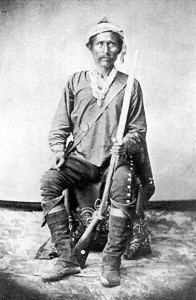Reservation Series: Navajo
# of Enrolled Tribal Members: 255,543* # of People on the Reservation: 298,197*
# Programs Partnering with us: 427 Sovereign Nation Since: 1868
Official Tribal Web Site: http://www.navajo-nsn.gov/index.htm
A Bit of Culture: Hogans are the traditional housing of the Dineh. The Navajo people are known for their silver and turquoise jewelry, hand-woven rugs, and Navajo code talkers. Traditional foods still in use today include blue corn mush, mutton stew, and kneeldown bread baked in a corn husk (aka Navajo tamales). The ever popular “Fry Bread” is delicious but not considered a “traditional” food; rather, fry bread was borne out of receiving government commodities such as white flour and findings ways to use it.
A Bit of History: Barboncito was the most predominant figure and leader of the Navajo people. Known as the “peace chief,” Barboncito grew up near Canyon de Chelly. In 1868, twenty-nine Navajo leaders including Barboncito signed the treaty that established the Navajo as a sovereign nation. The first tribal council was established in 1921. The capitol of the Navajo Nation is Window Rock, NM.
The Land: The Navajo population is at least 10 times larger than all other tribes in the U.S., with the exception of the Choctaw and other tribes in Oklahoma. The Navajo Nation consists of 27,000 square miles in Arizona, New Mexico, and Utah — the largest reserve in the U.S. Navajo tribal lands are a paradox: majestic beauty and rough terrain, a mix of arid deserts and canyons, mesas and mountains climbing 10,000 feet upward, volcanic activity, and dramatic erosion, and millions of acres of Ponderosa pine, Douglas fir, Piñon pine, and Juniper. Local water sources are somewhat limited, in part due to contamination from mining.
Current Economy: “The Navajo economy is often compared to a third world country.” But progress is being made. The Navajo Nation draws income from mining, tourism, land leases, taxes (including income tax), commercial entities and shopping centers, utilities, recently developed gaming, the Navajo Times newspaper, federal/state funding, and in-kind services related to health and education. Natural resources such as coal, oil, and gas, uranium, copper, fractured sand, helium, gypsum, clay, and gravel are also mined by non-tribal entities who lease mineral rights from non-tribal governmental authorities.
Education & Income: According to the Navajo Nation’s economic development report, the average high school graduation rate is 32%. About 5% of the Navajo people have a bachelor’s degree. Per capita income is about $7,100 per year, well below the U.S. average. Unemployment averages 50%. About 60% of the people live below poverty. Many people work in agricultural, manufacturing, or railroad jobs that are off-reservation. On the reservation, there are about 425 non-Native employers and 215 Native employers, tribal jobs, state and BIA jobs, and the industries mentioned above. Many of the geographic areas on the reservation lack the infrastructure to create businesses and jobs at this time. About 20% of the homes lack utilities (electricity and running water); about half of the homes lack telephones.
Learn More:
Navajo Culture: http://www.navajobusiness.com/fastFacts/Culture.htm
Navajo Business: http://www.navajobusiness.com/pdf/CEDS/CED_NN_Final_09_10.pdf
Navajo Lands: http://www.cba.nau.edu/caied/tribepages/Navajo.asp
*Reservation and Population figures from the 2000 Census
Subscribe to the blog and updates about our work in Indian Country
Popular Tags
American Indian American Indian history American Indian tribes code talker college Crow Creek diabetes disaster relief education Elders food food insecurity gardens Geronimo health Hopi hunger Indian country Indian history Indian reservations Indian tribes indigenous Indigenous people National Relief Charities Native American Navajo nutrition obesity Osama bin Laden Pine Ridge poverty Pueblos racial prejudice racial stereotypes school supplies self determination Sioux sovereignty students Sustainability Traditional food tribe names veteran veterans White Mountain Apache




4 Comments
They are one of the few people who still preserve their traditions despite living now in the reserves in an almost modernized world. It’s a good thing anyway that some of them have got a bachelor or a high education but I hope they will not forget their origins due to this.
Normally I do not read article on blogs, however I wish to say
that this write-up pressured me to do so! Thanks, very great article.
Brian obviously didn’t understand the article. Barely any of them have formal education because they don’t have the infrastructure to receive a proper education. They live in poverty. I think the majority of them are concerned with being more modernized and escaping poverty, rather than escaping their “origins” (it’s actually called culture…).
I am regular reader, how are you everybody? This article is in fact pleasant.
One Trackback
[…] ^ http://blog.nrcprograms.org/reservation-series-navajo/ […]